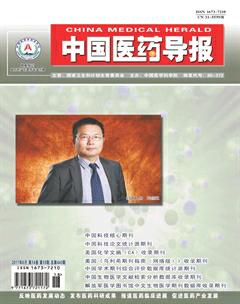伴有半月板损伤的膝骨关节炎患者采用关节镜治疗术后白介素—17的水平变化
张海森++++++白玉明++++++刘畅++++++靳胜利++++++苏珂++++++刘颖++++++吕志昌
[摘要] 目的 探讨关节镜手术治疗膝骨关节炎(OA)并内侧半月板损伤患者术后血浆和关节滑液中白介素-17(IL-17)的水平变化。 方法 以2014年1月~2015年6月因膝关节伴发内侧半月板损伤于沧州市中心医院接受关节镜治疗的46例患者作为试验组,以30例膝关节正常自愿者作为对照组。试验组术后采用Lysholm评分评价膝关节功能,视觉模拟(VAS)疼痛评分评价膝关节疼痛程度。术前及术后3、6、12个月抽取患者肘部静脉血液以及患侧膝关节滑液,采用ELISA检测试剂盒测量血浆及关节滑液IL-17含量,对照组抽取肘部静脉血进行相应检测并比较。 结果 试验组患者术后切口均Ⅰ期愈合;均获随访,随访时间为12~18个月,平均15个月。试验组术后各时间点VAS评分均较术前显著降低,而Lysholm评分较术前显著增加,差异有统计学意义(P < 0.05);而术后各时间点间比较,差异无统计学意义(P > 0.05)。与对照组相比,试验组术前血浆IL-17含量显著增高,差异有统计学意义(P < 0.05);血浆及关节滑液IL-17含量在术后各时间点均较术前显著降低(P < 0.05),但血浆IL-17含量均高于对照组水平(P < 0.05)。试验组术后各时间点血浆及关节滑液IL-17含量比较差异无统计学意义(P > 0.05)。 结论 关节镜手术可显著改善膝骨关节OA伴内侧半月板损伤患者的疼痛癥状和关节功能,并在一定程度上降低患者体内IL-17水平,但尚未恢复至正常水平。
[关键词] 关节镜手术;骨关节炎;膝;半月板损伤;白介素-17
[中图分类号] R683 [文献标识码] A [文章编号] 1673-7210(2017)06(c)-0087-04
[Abstract] Objective To investigate interleukin-17 (IL-17) levels in both synovial fluid and plasm of patients with primary knee medial osteoarthritis (OA) accompanied by medial meniscus injuries after arthroscopic surgery. Methods 46 patients with primary knee OA accompanied by medial meniscus injuries underwent arthroscopic surgery in Central Hospital of Cangzhou from January 2014 to June 2015 were selected as the experimental group, and 30 healthy individuals were selected as the control group. Visual analog scale (VAS) pain score and Lysholm score were used to evaluate the pain level and function of the knees of patients with OA. The IL-17 concentrations in both plasma and synovial fluid of patients were measured at preoperative period and postoperative 3, 6, 12 months, and in plasma of controls were determined using auantitative sandwich enzyme-linked immunoassay. Results Postoperative incisions were Ⅰ stage healing for patients. All patients were followed up for 12-18 months, average of 15 months. Postoperative VAS pain scores significantly decreased and Lysholm scores significantly increased compared with preoperative periods (P < 0.05). For VAS scores and Lysholm scores, there were no statistically significant differences between postoperative points (P > 0.05). Patients before arthroscopic surgery had higher plasma IL-17 concentrations compared to control group (P < 0.05). Average postoperative IL-17 levels in plasma at each time point of patients were significant lower than preoperative periods (P < 0.05), but higher than control group (P < 0.05). Postoperative plasm and synovial fluid IL-17 levels of patients after the surgery had no statistically significant differences among postoperative points (P > 0.05). Conclusion Arthroscopic surgery can significantly improve the pain symptoms and joint function and reduce IL-17 levels in both synovial fluid and plasm of the patients with knee OA accompanied by medial meniscus injuries, but IL-17 can not back to healthy level.
[Key words] Arthroscopic surgery; Osteoarthritis; Knee; Meniscus injury; Interleukin-17
骨关节炎(osteoarthritis,OA)是一种复杂的关节滑膜及关节软骨炎性疾病[1],由于炎性细胞因子破坏了软骨细胞的合成与分解代谢平衡,进而在OA发生与发展中起重要作用[2-3]。最近研究表明,白介素-17(IL-17)基因多态性与OA的易感性相关[4],膝骨关节炎患者血浆及关节炎滑液中可表达高于健康人水平的IL-17[5-6]。膝关节OA早期,患者常表现为单纯内侧间室关节炎,而这类患者常常同时伴发半月板损伤[7-10]。尽管半月板损伤的治疗目前仍存有争议[11-13],但对于临床保守治疗无效的病例,关节镜治疗由于其创伤小、并发症少,选择性应用仍具有一定的治疗价值。本研究以膝关节OA伴发内侧半月板损伤采用关节镜治疗患者为研究对象,观察治疗前后患者血浆和关节滑液中IL-17变化情况,并与膝关节正常志愿者进行比较,以期了解IL-17在关节镜治疗OA伴半月板损伤术后患者体内变化情况。
1 资料与方法
1.1 一般资料
本研究获得沧州市中心医院(以下简称“我院”)伦理委员会批准,所有研究对象均为汉族国人,纳入研究前均签署知情同意书。以2014年1月~2015年6月因膝关节OA伴发内侧半月板损伤于我院采用关节镜治疗的46例患者作为试验组。另选择30名健康志愿者作为对照组。
试验组:男19例,女27例;平均年龄为(50.8±4.9)岁;体重指数(body mass index,BMI)为(26.9±3.5)kg/m2;左膝18例,右膝28例;半月板损伤病程为(6.8±4.6)周。主要临床症状为膝关节内侧疼痛、轻度肿胀、关节绞索及行走功能障碍等;主要阳性体征为内侧股胫关节间隙压痛。经膝关节MRI检查,结合临床症状、体征确定诊断为膝内侧间室OA伴内侧半月板损伤[11]。经膝关节X线片检查,所有患者Kellgren-Lawrence(KL)法[14]分级为Ⅰ级或Ⅱ级。
对照组:男13例,女17例;平均年龄为(51.9±4.7)岁;BMI为(27.7±3.9)kg/m2。经X线检查排除膝关节病变,膝关节X线片评价均为KL 0级。排除存在关节痛、关节功能受限、糖尿病、糖皮质激素类用药史、其他类型关节炎罹患史及癌症等志愿者。
两组研究对象性别、年龄、BMI比较,差异均无统计学意义(P > 0.05)。所有研究对象均排除风湿免疫性疾病、血液肿瘤性疾病、内分泌疾病和严重的心、肝、肾等脏器功能障碍情况。
1.2 手术方法
采用1%利多卡因于局部浸润麻醉下实施手术。常规采用髌下内、外侧膝关节镜入路。术中采用刨刀对增生炎性滑膜、漂浮的软骨碎屑及龟裂严重的软骨进行清理;采用射频刀止血,修整软骨缺损边缘,使之平整;采用蓝钳对损伤半月板行成形术,射频修整边缘。术毕皮内缝合手术切口。
1.3 术后处理及观测指标
试验组术后患膝冰敷6 h。术后第2天即开始功能锻炼,适度负重活动。采用Lysholm评分[15]评价膝关节功能,采用视觉模拟(visual analogue scale,VAS)疼痛评分[16]评价膝关节疼痛程度。术前及术后3、6、12个月抽取肘部静脉血液10 mL以及患侧膝关节滑液2 mL。采用ELISA检测试剂盒测量血浆及关节滑液IL-17含量。对照组仅抽取肘部静脉血进行相应检测。
1.4 统计学方法
采用SPSS 13.0统计学软件进行数据分析,计量资料数据用均数±标准差(x±s)表示,两组间比较采用t检验,同组间不同时间点的比较采用重复测量的方差分析;计数资料用率表示,组间比较采用χ2检验。以P < 0.05为差异有统计学意义。
2 结果
2.1 试验组手术前后VAS及Lysholm评分情况
试验组患者术后切口均Ⅰ期愈合,无切口感染等手术相关并发症发生。术后均获随访,随访时间为12~18个月,平均15个月。术后各时间点VAS评分均较术前显著降低,Lysholm评分较术前显著增加,差异有统计学意义(P < 0.05);术后各时间点间比较,差异无统计学意义(P > 0.05)。见表1。
2.2 两组IL-17水平比较
对照组血浆IL-17含量为(2.4±1.7)pg/mL。与对照组比较,试验组术前血浆IL-17含量显著增高,差异有统计学意义(P < 0.05);血浆及关节滑液IL-17含量在术后各时间点均较术前显著降低(P < 0.05),但血浆IL-17含量均高于对照组水平(P < 0.05)。术后各时间点血浆及关节滑液IL-17含量比较差异无统计学意义(P > 0.05)。见表2。
3 讨论
相关研究表明,OA患者IL-17水平显著高于健康人群[2,17-19]。在OA发生过程中IL-17可针对软骨细胞和滑膜成纤维细胞膜表面的抗原发生直接细胞免疫应答效应[20-21],IL-17可上调软骨细胞及滑膜成纤维细胞MMP的表达,而后者是软骨降解的潜在物质[20]。IL-17还可增强关节软骨细胞一氧化氮合酶表达,诱导关节软骨的破坏[22]。
以往对于膝关节镜治疗半月板损伤的相关基础研究相对较少,报道多集中于对其临床疗效的评估[11-13,15],关节镜治疗术后患者机体内相关炎性细胞因子的水平变化如何,尚未见相关报道。本研究对关节镜治疗膝关节OA伴发半月板损伤患者的血浆和关节滑液中细胞因子IL-17水平进行了检测,数据结果显示,内侧间室膝关节OA并内侧半月板损伤患者在接受关节镜手术治疗3个月后血浆及关节滑液IL-17含量较术前显著降低(P < 0.05),但仍高于健康对照组水平。术后临床随访发现,患者术后3个月VAS疼痛评分及Lysholm评分较术前显著改善,直至术后12个月未见疼痛加重及功能丢失情况,术后各时间点IL-17水平差异无统计学意义(P > 0.05)。本研究结果表明,关节镜手术可显著改善内侧间室膝关节OA伴内侧半月板损伤患者的疼痛症状和关节功能,并可在一定程度上降低患者体内IL-17水平,但不能使这些细胞因子恢复至健康人水平。本研究提示膝關节镜手术具有改善OA并半月板损伤患者机体生物学环境的效果,但不能逆转OA的病理过程。因此,有望进一步研究通过关节镜手术联合其他生物学方法实现更为有效治疗OA及半月板损伤的目的。
在研究的局限性方面,首先,本研究为一项单中心实验研究,样本量相对较小,因此尚需进一步实施大样本、多中心前瞻性随机对照研究以证实研究结果的可靠性。另外,本研究只对研究对象血浆和滑液中的IL-17水平进行了检测,而与OA相关的炎症因子很多,本研究选取的这一细胞因子可能不能完全代表其他因子的水平。最后,鉴于接受关节镜手术治疗的OA患者体内IL-17水平可能会受到手术刺激、麻醉、术后药物治疗等因素影响,因此IL-17水平检测时间设定在术后3个月以及之后,此时患膝肿胀消退,行走能力已基本恢复正常,患者无需OA相关的药物治疗,手术本身造成的机体内环境改变基本得以恢复。但是,对于患者的职业因素、环境因素、运动活动水平不可能完全控制,因此,这些因素会否影响实验结果尚需更趋设计严谨的试验研究证实。
[参考文献]
[1] Cooper BG,Stewart RC,Burstein D,et al. A Tissue-Penetrating Double Network Restores the Mechanical Properties of Degenerated Articular Cartilage [J]. Angew Chem Int Ed Engl,2016,55(13):4226-4230.
[2] Honsawek S,Deepaisarnsakul B,Tanavalee A,et al. Association of the IL-6-174G/C gene polymorphism with knee osteoarthritis in a Thai population [J]. Genet Mol Res,2011,10(3):1674-1680.
[3] Hulin-Curtis SL,Bidwell JL,Perry MJ. Evaluation of IL18 and IL18R1 polymorphisms:genetic susceptibility to knee osteoarthritis [J]. Int J Immunogenet,2012,39(2):106-109.
[4] 張海森,白玉明,靳胜利,等.白细胞介素-17基因多态性与骨关节炎易感性之间的相关性研究[J].中华骨科杂志,2016,36(22):1450-1455.
[5] 张海森,白玉明,刘畅,等.血清及滑液白介素-17水平与膝骨关节炎退变及膝痛程度的相关性研究[J].中国医药导报,2016,13(33):84-87.
[6] Kan JI,Mishima S,Kashiwakura JI,et al. Interleukin-17A expression in human synovial mast cells in rheumatoid arthritis and osteoarthritis [J]. Allergol Int,2016,65 Suppl:S11-S16.
[7] Pihl K,Englund M,Lohmander LS,et al. Signs of knee osteoarthritis common in 620 patients undergoing arthroscopic surgery for meniscal tear[J]. Acta Orthopaedica,2017,88(1):1-6.
[8] Hunter DJ,Zhang YQ,Niu JB,et al. The association of meniscal pathologic changes with cartilage loss in symptomatic knee osteoarthritis[J]. Arthritis Rheumatol,2006,54(3):795-801.
[9] Englund M,Haugen IK,Guermazi A,et al. Evidence that meniscus damage may be a component of osteoarthritis:the Framingham study[J]. Osteoarth Cartilage,2015,24(2):270-273.
[10] Cho SD,Youm YS,Kim JH,et al. Patterns and Influencing Factors of Medial Meniscus Tears in Varus Knee Osteoarthritis[J]. Knee Surg Related Res,2016,28(2):142.
[11] Babu J,Shalvoy RM,Behrens SB. Diagnosis and Management of Meniscal Injury[J]. R I Med J,2016,99(10):27-30.
[12] Choi NH,Oh JS. Management of Meniscal Injury:Repair,Meniscectomy,and Transplantation [J]. J Korean Orthop Assoc,2012,47(3):165.
[13] Mitchell J,Graham W,Best TM,et al. Epidemiology of meniscal injuries in US high school athletes between 2007 and 2013 [J]. Knee Surg Sports Traumatol Arthroscopy Official J Esska,2015,24(3):1-8.
[14] Oudenaarde KV,Jobke B,Oostveen ACM,et al. Predictive value of MRI features for development of radiographic osteoarthritis in a cohort of participants with pre-radiographic knee osteoarthritis-the CHECK study [J]. Rheumatology,2017,56(1):113-120.
[15] Briggs KK,Kocher MS,Rodkey WG,et al. Reliability,validity,and responsiveness of the Lysholm knee score and Tegner activity scale for patients with meniscal injury of the knee [J]. J Bone Joint Surg,2006,88(88):698-705.
[16] Karabis A,Nikolakopoulos S,Pandhi S,et al. High correlation of VAS pain scores after 2 and 6 weeks of treatment with VAS pain scores at 12 weeks in randomised controlled trials in rheumatoid arthritis and osteoarthritis:meta-analysis and implications [J]. Arthritis Res Ther,2016,18(1):1-7.
[17] Bondeson J,Wainwright SD,Lauder S,et al. The role of synovial macrophages and macrophage-produced cytokines in driving aggrecanases,matrix metalloproteinases,and other destructive and inflammatory responses in osteoarthritis [J]. Arthritis Res Ther,2006,8(6):R187.
[18] Wu X,Kondragunta V,Kornman KS,et al. IL-1 receptor antagonist gene as a predictive biomarker of progression of knee osteoarthritis in a population cohort [J]. Osteoarthritis Cartilage,2013,21(7):930-938.
[19] Chen L,Li DQ,Zhong J,et al. IL-17RA aptamer-mediated repression of IL-6 inhibits synovium inflammation in a murine model of osteoarthritis [J]. Osteoarthritis Cartilage,2011,19(6):711-718.
[20] Wang K,Xu J,Cai J,et al. Serum levels of interleukin-17 and adiponectin are associated with infrapatellar fat pad volume and signal intensity alteration in patients with knee osteoarthritis [J]. Arthritis Res Ther,2016,18(1):193.
[21] Deligne C,Casulli S,Pigenet A,et al. Differential expression of interleukin-17 and interleukin-22 in inflamed and non-inflamed synovium from osteoarthritis patients [J]. Osteoarthritis Cartilage,2015,23(11):1843-1852.
[22] Wang K,Xu J,Cai J,et al. Serum levels of resistin and interleukin-17 are associated with increased cartilage defects and bone marrow lesions in patients with knee osteoarthritis [J]. Mod Rheumatol,2017,27(2):339-344.

